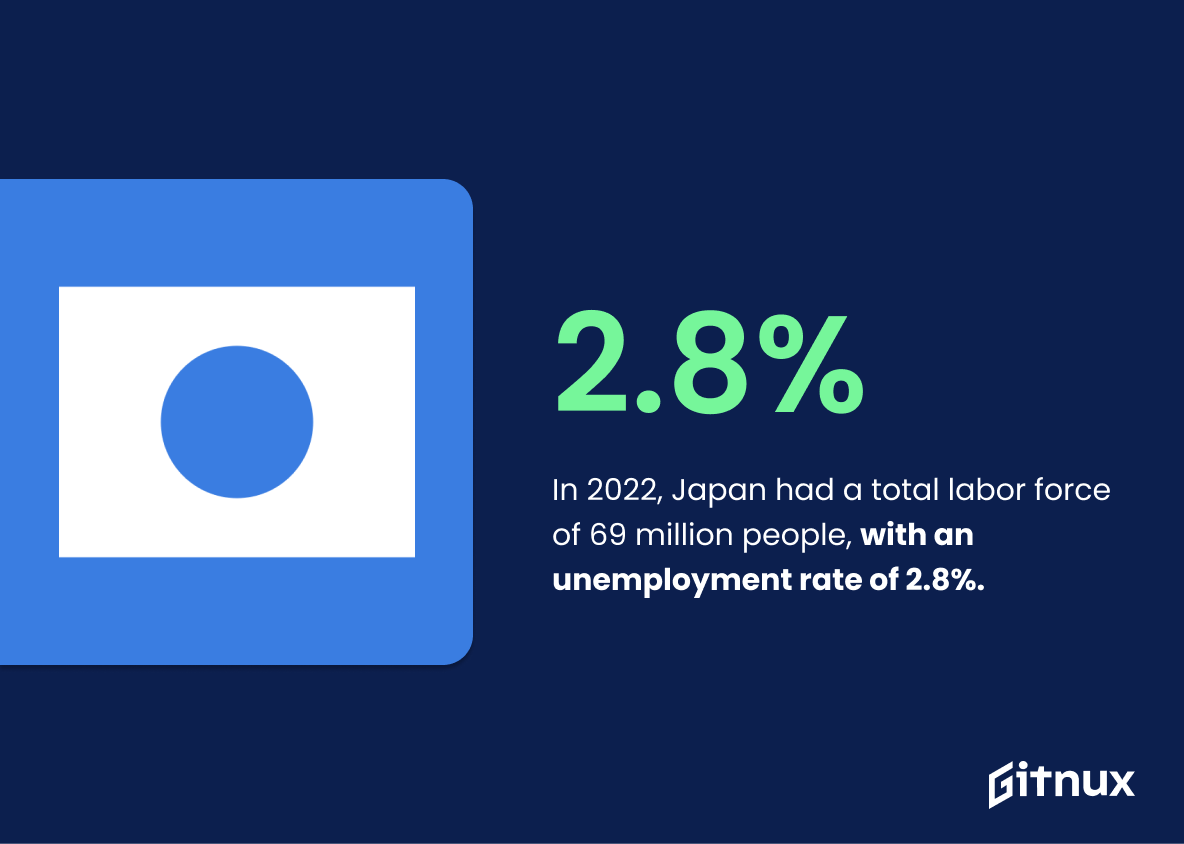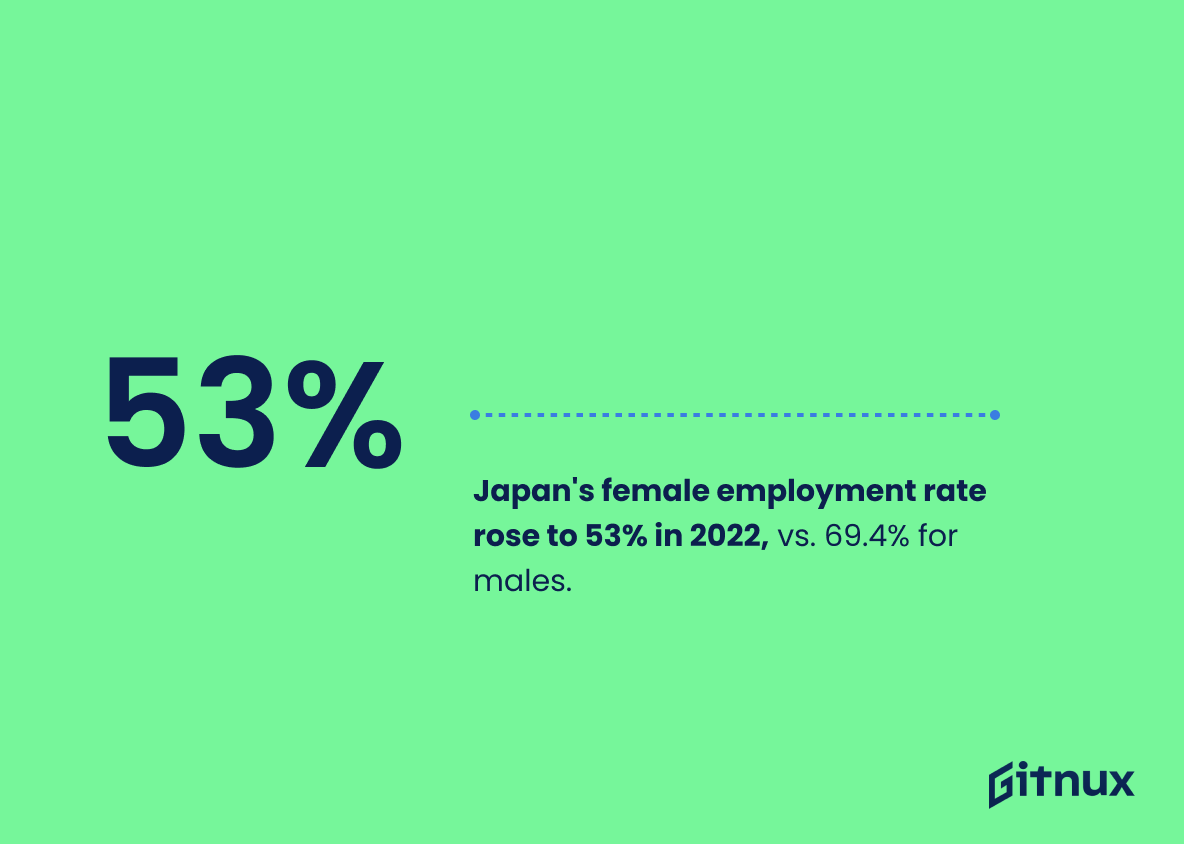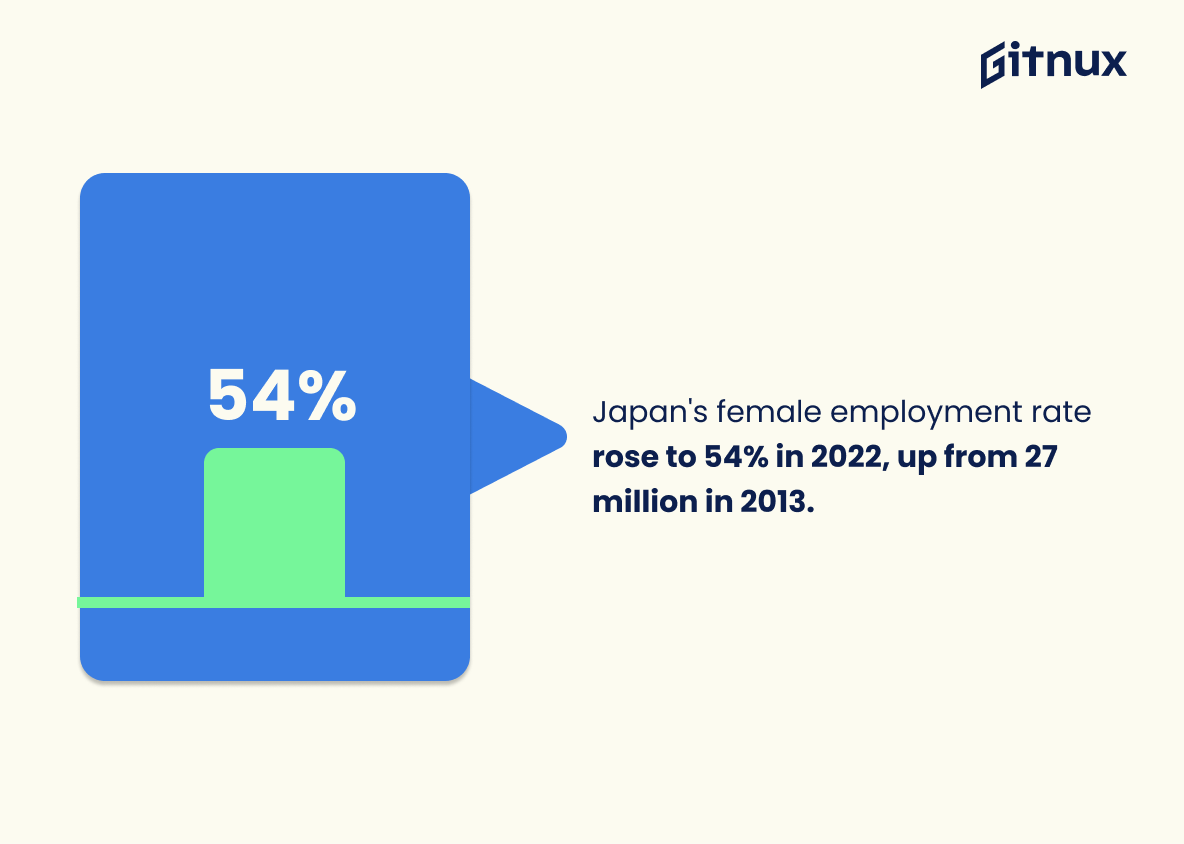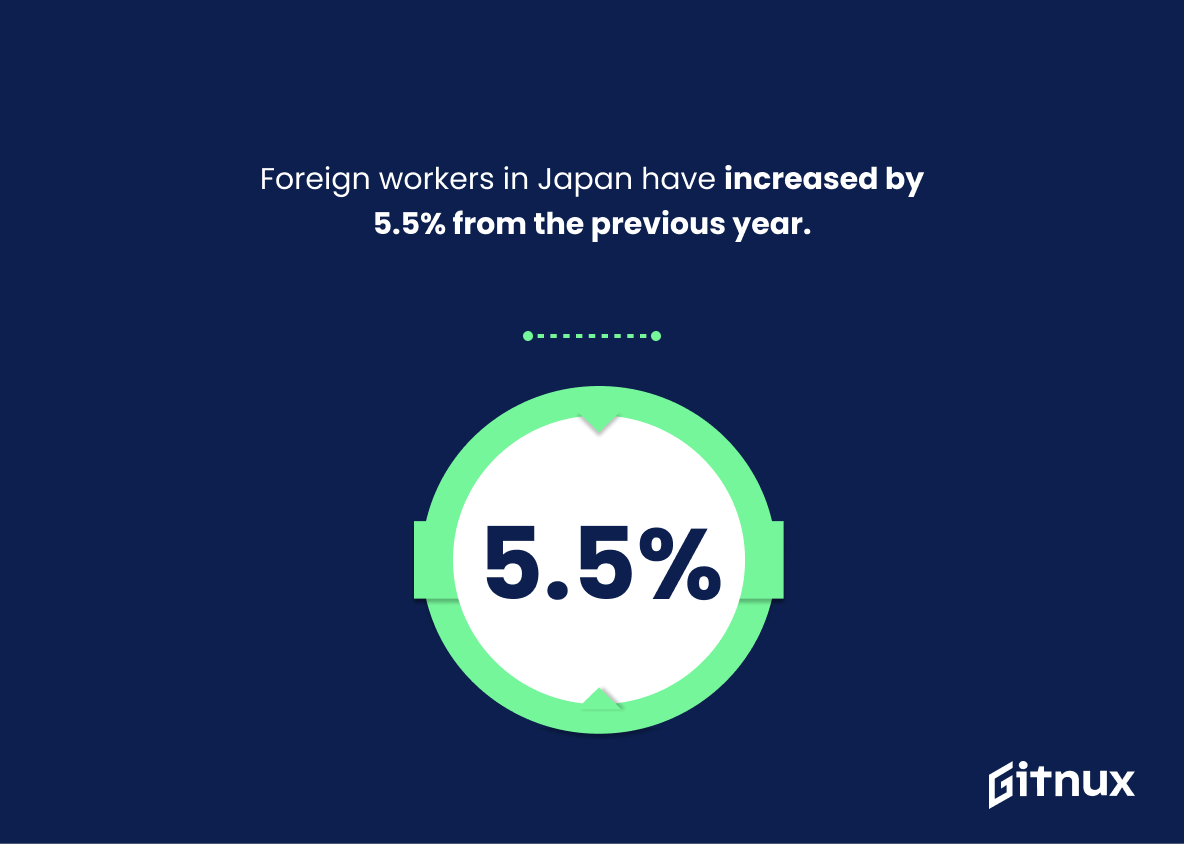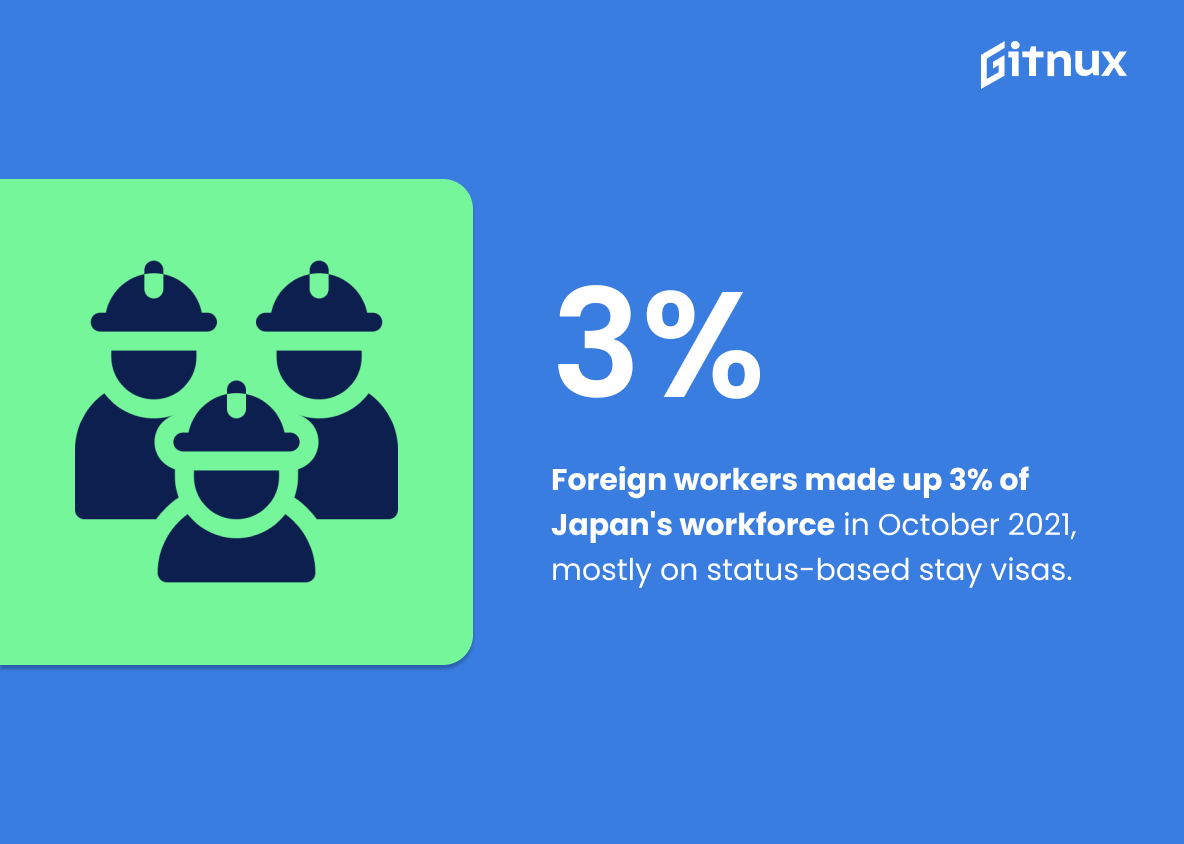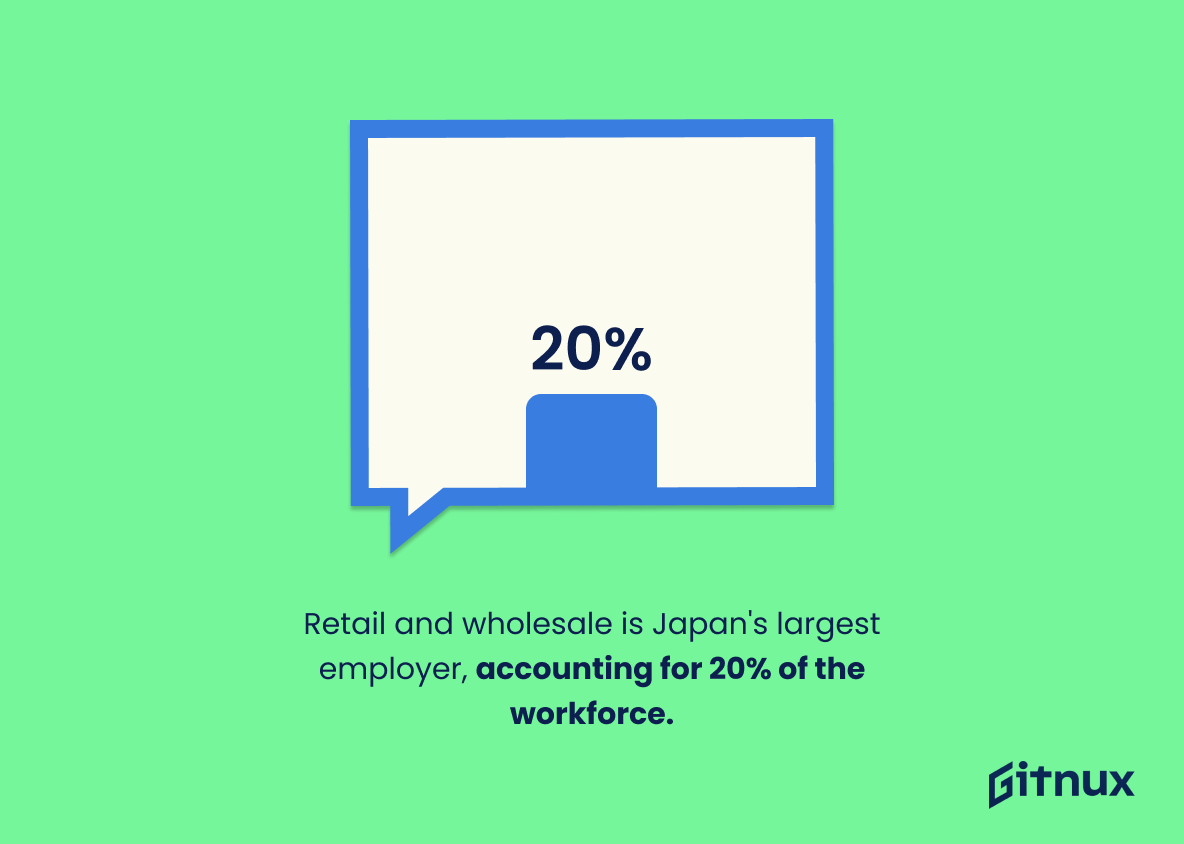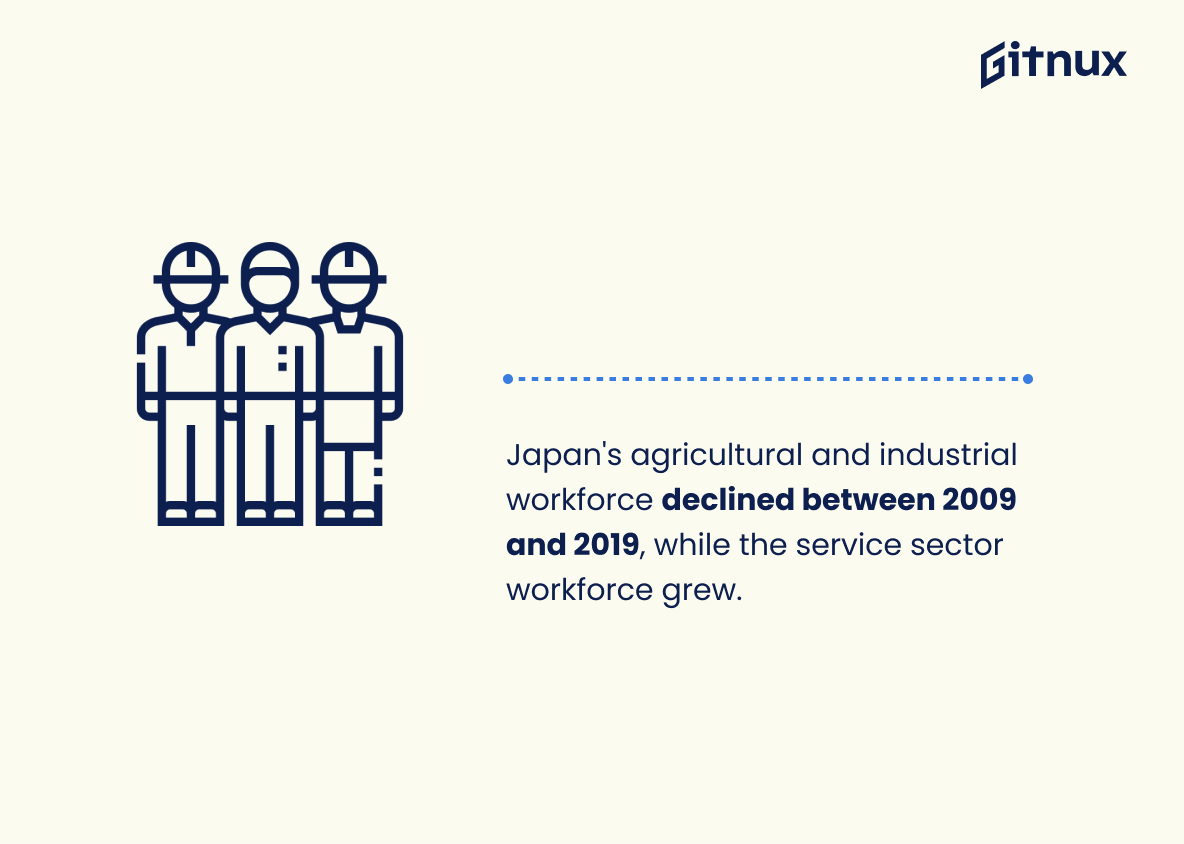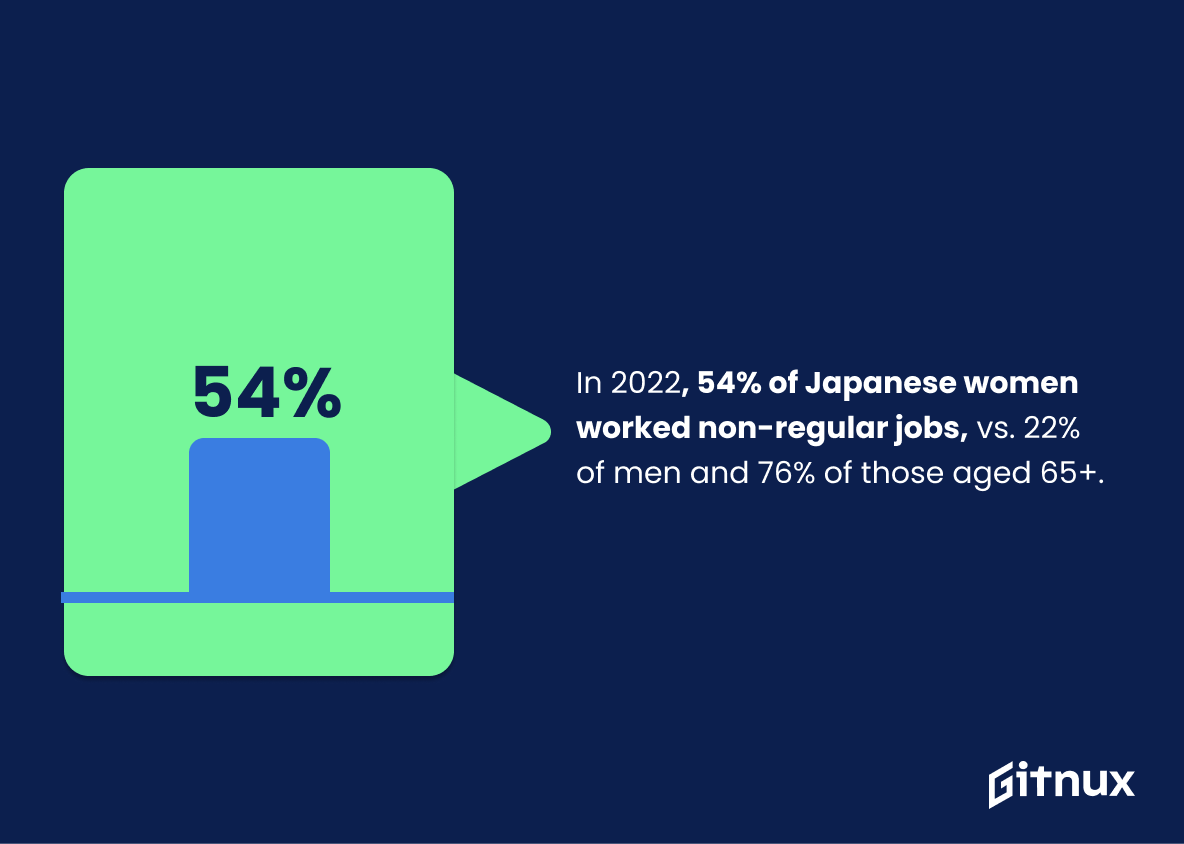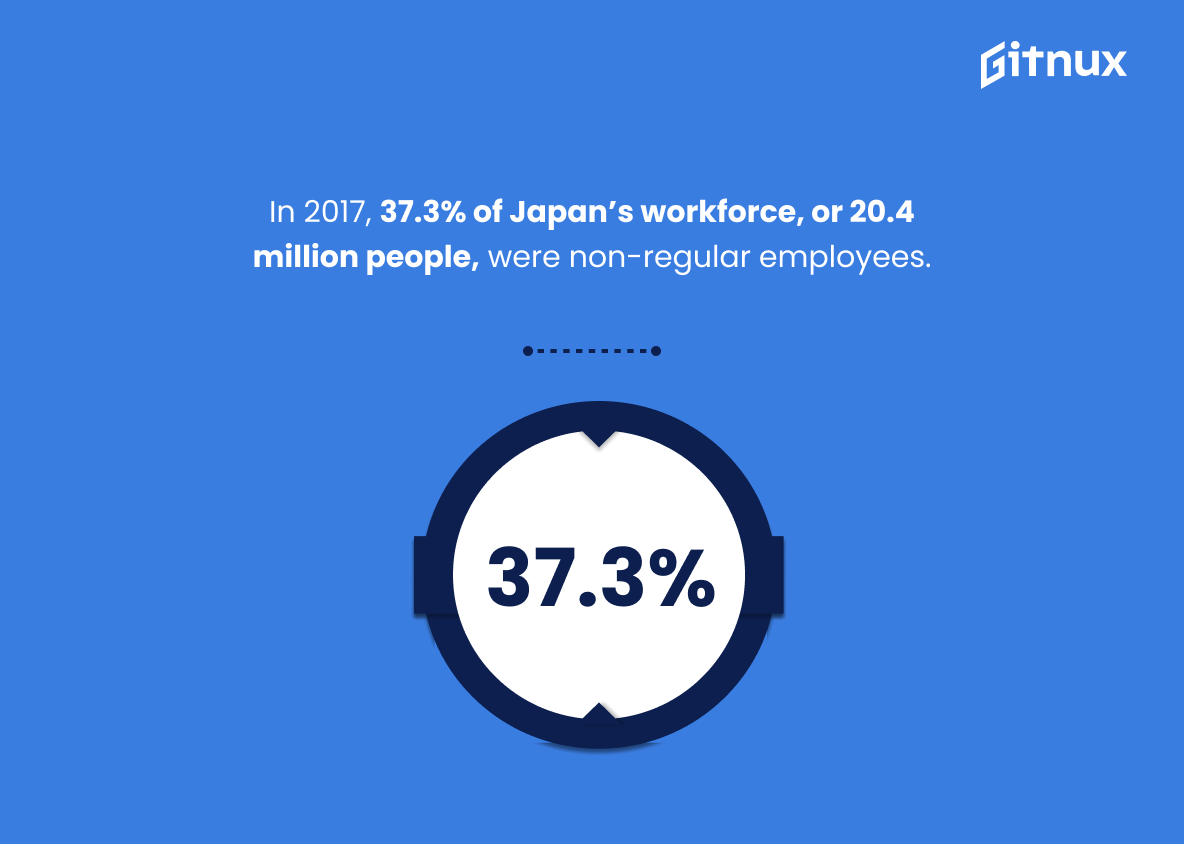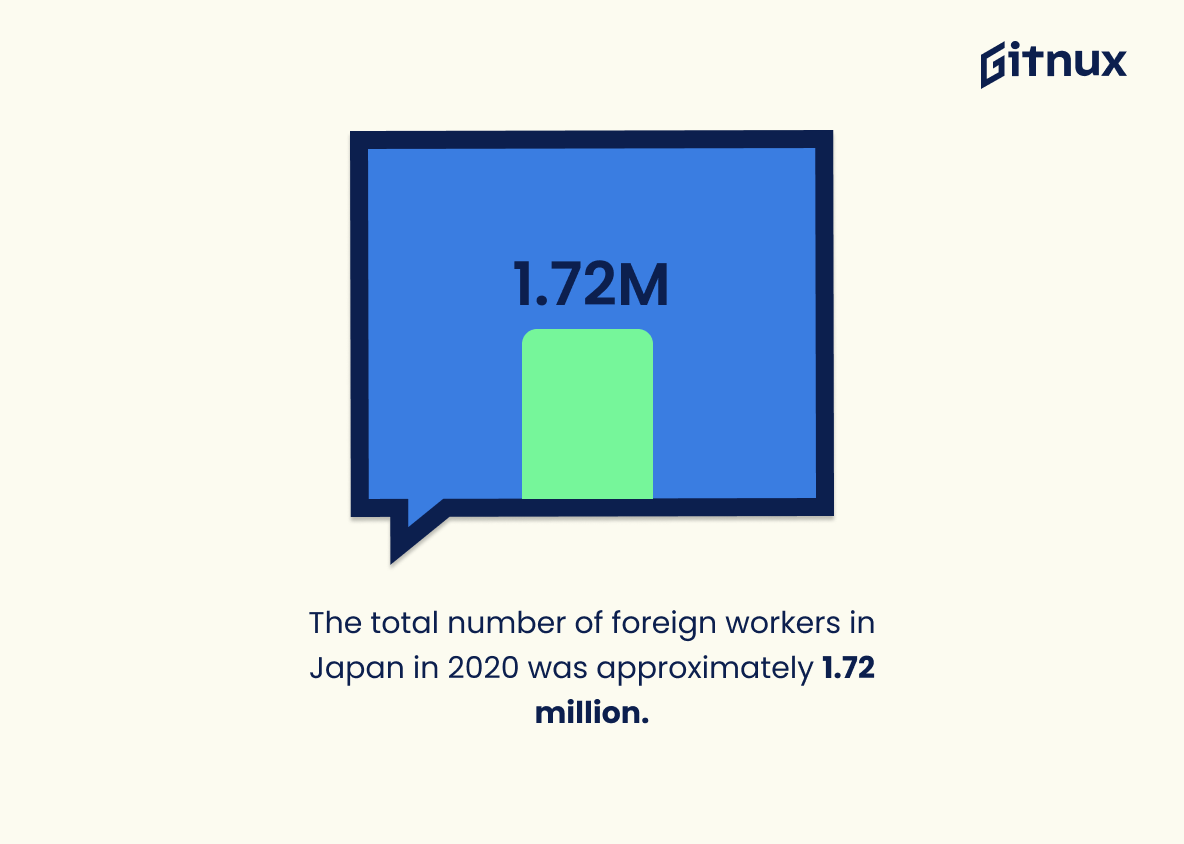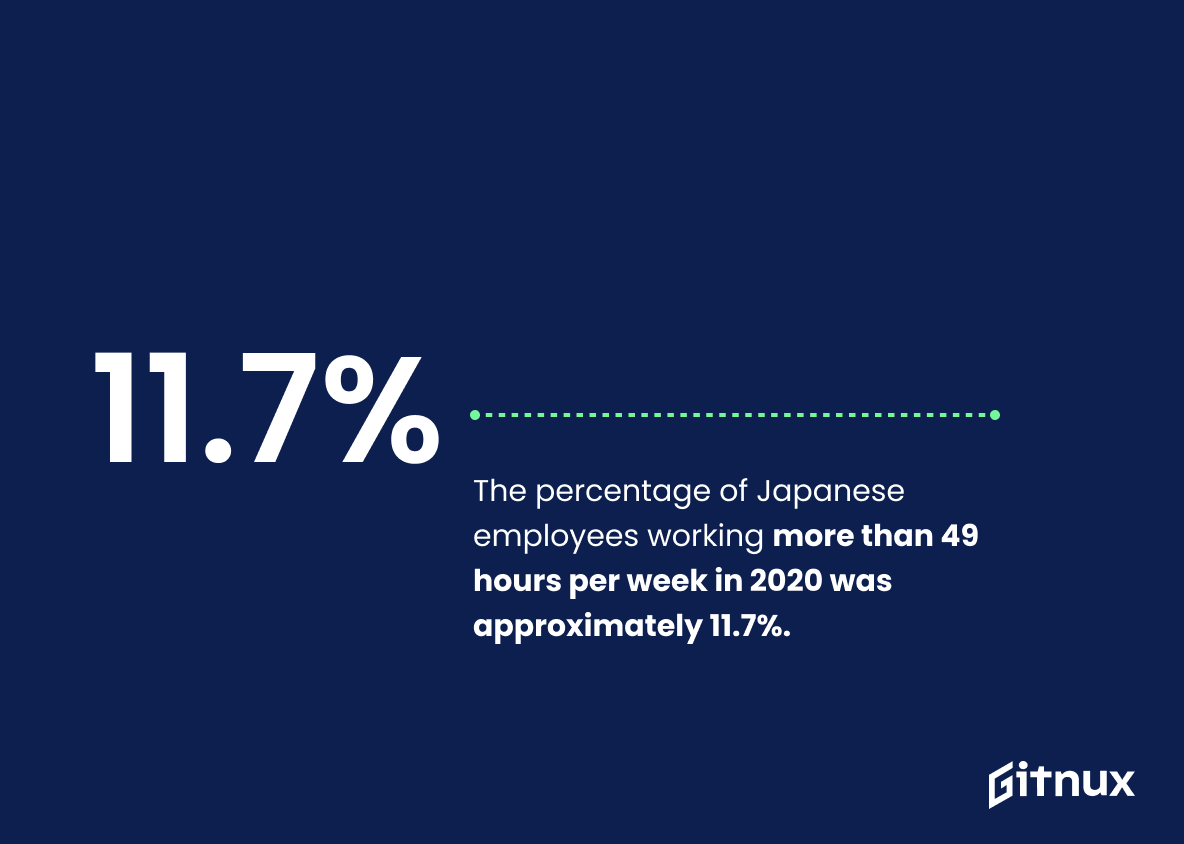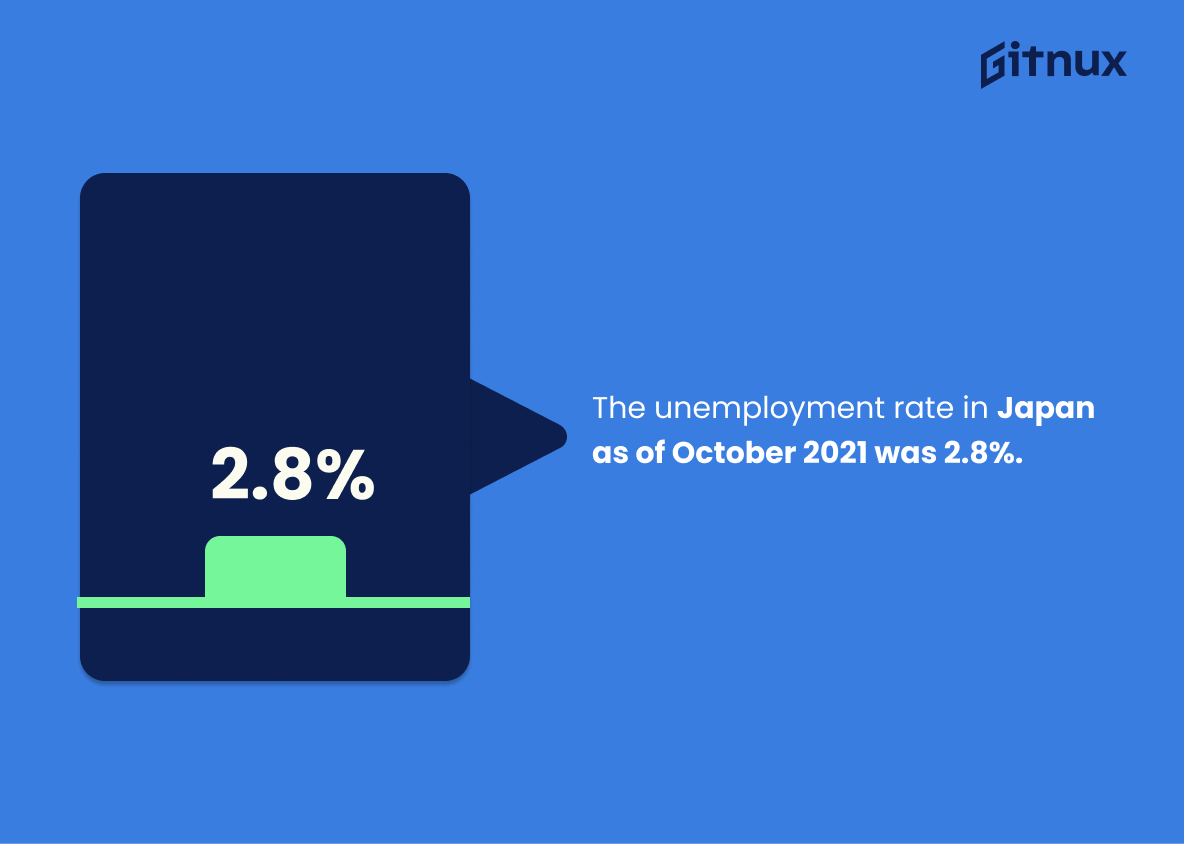Japan is known for its highly educated and efficient workforce. It is also known for its low unemployment rate and high productivity. In this blog post, we will take a closer look at the workforce statistics of Japan and discuss what makes the Japanese workforce so successful.
We will also explore the challenges that Japan faces in terms of its workforce and how it is addressing them. Finally, we will discuss the implications of these workforce statistics for businesses looking to expand into Japan.
Japan Workforce: The Most Important Statistics
- The labor force participation rate in Japan decreased to 62.2% in January 2023 and the employment rate decreased to 60.7%. The unemployment rate was 2.4% and the youth unemployment rate was 4.5%.
- The female employment rate in Japan increased from 47% to 53% between 2013 and 2022, while the male employment rate was 69.4% in 2022.
- Foreign workers in Japan have increased by 5.5% from the previous year, with the majority being Vietnamese (25.4%), Chinese (21.2%), and Filipino (11.3%).
Japan Workforce Statistics Overview
In 2022, Japan had a total labor force of 69 million people, with an unemployment rate of 2.8%.
Thus, Japan has a relatively low unemployment rate compared to other major industrial and emerging countries, indicating that the country is doing well in terms of providing employment opportunities for its citizens.
The labor force participation rate in Japan decreased to 62.2% in January 2023 and the employment rate decreased to 60.7%. The unemployment rate was 2.4% and the youth unemployment rate was 4.5%.
This shows that the youth unemployment rate is higher than the overall unemployment rate, which could have long-term implications for the Japanese workforce.
The female employment rate in Japan increased from 47% to 53% between 2013 and 2022, while the male employment rate was 69.4% in 2022.
Therefore, there is still a gap between the employment rate of men and women in the country. This gap can be attributed to the lack of gender equality in the workplace and the lack of support for working mothers. It is important for Japan to address these issues in order to ensure that women are able to participate in the workforce and contribute to the economy.
In 2022, 54% of women aged 15 or older in Japan were employed, amounting to 30.2 million people, an increase from 27 million in 2013.
Japan has made progress in increasing the number of women in the workforce, which is important for the country’s economic growth and development. Additionally, this indicates that more women are taking on roles in the workforce and contributing to the economy, which is beneficial for society as a whole.
Foreign workers in Japan have increased by 5.5% from the previous year, with the majority being Vietnamese (25.4%), Chinese (21.2%), and Filipino (11.3%).
The manufacturing industry has the highest percentage of foreign workers, followed by the service industry, which shows the growing reliance of Japan on foreign labor, especially in the manufacturing and service industries.
As of October 2021, foreign workers accounted for 3% of all employees in Japan, with the majority on a “status-based stay” visa.
Japan is gradually opening up its labor market to foreign workers, which could help to address the country’s aging population and shrinking workforce.
Retail and wholesale industry employs the largest number of people in Japan, representing 20% of the total employed population.
This provides insight into the industries that employ the most people in Japan, and the number of foreign people employed in the manufacturing industry.
The percentage of the workforce employed in agriculture and industry has decreased while the percentage employed in services has increased between 2009 and 2019 in Japan.
It shows a shift in the structure of the Japanese workforce, with a decrease in the number of people employed in agriculture and industry and an increase in the number of people employed in services.
In 2022, 54% of female employees in Japan were working in non-regular employment, compared to 22% of men and 76% of those aged 65 and older.
This highlights the gender gap and age gap in the Japanese workforce. Women and older employees are disproportionately represented in non-regular employment, which often offers fewer benefits and job security than regular employment.
In 2017, 37.3% of Japan’s workforce, or 20.4 million people, were non-regular employees.
Japan’s labor force in October 2021 was approximately 66.97 million people.
This is an important piece of information for anyone looking to understand the current state of the Japanese labor market and the potential for future development. By understanding the size of the labor force, one can gain a better understanding of the potential for job creation, the availability of skilled labor, and the overall health of the economy. This statistic is essential for anyone looking to gain a comprehensive understanding of Japan’s workforce and its potential for growth.
The total number of foreign workers in Japan in 2020 was approximately 1.72 million.
Foreign workers make up a significant portion of the total workforce, highlighting the importance of international labor in the country’s economy. Furthermore, it provides insight into the potential for further growth in the number of foreign workers in Japan, as well as the potential for increased economic activity and job opportunities.
The percentage of Japanese employees working more than 49 hours per week in 2020 was approximately 11.7%.
A significant portion of the population was working long hours, which can have a detrimental effect on their physical and mental health. This statistic is important to consider when discussing Japan’s workforce statistics, as it provides insight into the working conditions of many Japanese employees.
The unemployment rate in Japan as of October 2021 was 2.8%.
The serves as a barometer of the country’s economic health, providing insight into the number of people who are actively seeking employment but unable to find it. This statistic is a valuable indicator of the overall health of the Japanese labor market and can be used to inform decisions about job creation, wages, and other economic policies.
In 2021, the labor force participation rate for Japanese women aged 15-64 was around 70%.
Japanese women are increasingly taking part in the labor force, which is a positive sign for the country’s economic growth and development. It also highlights the importance of creating an environment that is conducive to women’s participation in the workforce, and the need for policies that support and encourage women’s labor force participation.
Approximately 12.5% of Japan’s population in 2020 was engaged in agriculture, forestry, and fishing.
A significant portion of the population is still engaged in agriculture, forestry, and fishing, suggesting that the country has yet to fully transition to a more modernized economy. This is an important factor to consider when discussing Japan’s workforce statistics, as it provides insight into the country’s economic development.
Japan’s total number of employment in high-tech industries in 2020 was around 3.14 million.
Despite the economic downturn caused by the pandemic, Japan’s high-tech industries have remained resilient and continue to provide employment opportunities for millions of people. This is a testament to the strength of Japan’s economy and its ability to adapt to changing circumstances.
The labor productivity growth rate in Japan in 2020 was approximately -1.2%.
The country’s labor productivity has taken a hit, indicating that the workforce has been unable to keep up with the demands of the economy. This could have serious implications for the country’s economic growth and could lead to further job losses and economic hardship.
Japan’s average retirement age in 2021 was 61.
Japan’s average retirement age in 2021 was 61 is a telling statistic when it comes to the state of the Japanese workforce. It speaks to the longevity of the Japanese workforce, as well as the overall health of the economy. It also indicates the level of job security that Japanese workers enjoy, as well as the level of job satisfaction they experience. This statistic is a key indicator of the overall health of the Japanese workforce and its ability to remain competitive in the global economy.
Japan’s workforce shrank by approximately 3.7 million between 2000 and 2020.
This highlights the need for a comprehensive understanding of the current state of the Japanese workforce and the challenges it faces in the future. It also serves as a warning to other countries that may be facing similar issues, as it demonstrates the potential consequences of a shrinking workforce.
Japan’s youth unemployment rate (15-24 years) in 2020 was around 9%.
The speaks to the current economic climate and the challenges that young people face in finding employment. This statistic is especially important in the context of a blog post about Japan’s workforce statistics, as it provides a snapshot of the current state of the labor market and the difficulties that young people are facing in finding work.
In 2019, around 6.78 million Japanese employees were working in the manufacturing sector.
This highlights the sheer number of people employed in the industry, demonstrating the significance of the sector in providing jobs and contributing to the nation’s economic growth.
The share of part-time employment in Japan in 2019 was 31.4%.
A significant portion of the population is employed part-time, which can have a variety of implications. For instance, it could suggest that there is a lack of full-time job opportunities, or that people are choosing to work part-time for other reasons. This statistic is an important piece of the puzzle when it comes to understanding the Japanese workforce.
Japan’s total employment rate in 2020 was 76.2%.
This provides insight into the number of people who are actively employed and the overall economic health of the country. This statistic is especially important in the context of a blog post about Japan Workforce Statistics, as it gives readers a comprehensive overview of the current employment situation in Japan.
The percentage of Japanese workers with higher education in 2020 was around 47.4%.
Japanese workforce has, and can be used to gauge the potential of the workforce to contribute to the economy. It also provides insight into the potential of the workforce to take on more complex roles and responsibilities, as well as the potential for innovation and creativity. In short, this statistic is an important indicator of the overall strength of the Japanese workforce.
The nominal hourly wage in Japan in 2020 was 1,078 yen (approximately $10.26 in 2020).
This provides insight into the wages that workers in Japan are earning, and can be used to compare the wages of different countries. Additionally, it can be used to measure the purchasing power of the Japanese workforce, and to gauge the overall economic health of the country.
In 2020, Japan had a professional and technical personnel-to-population ratio of 64.44 per 1,000 population.
The country has a high concentration of professional and technical personnel, which is essential for a modern economy. This statistic is especially important in the context of a blog post about Japan’s workforce statistics, as it provides a snapshot of the country’s current capabilities and potential for growth.
The annual number of Japanese job vacancies in 2020 was around 2.49 million.
This provides insight into the number of job opportunities available to the Japanese workforce, and can be used to gauge the overall health of the country’s economy. It is an important piece of information for anyone looking to gain a better understanding of the Japanese job market and the current state of the workforce.
The number of self-employed workers in Japan in 2021 was approximately 11.6 million.
A significant portion of the population is self-employed, which speaks to the prevalence of entrepreneurship and independent work in the country. This statistic is an important piece of the puzzle when it comes to understanding the dynamics of the Japanese labor market.
Conclusion
In conclusion, Japan’s workforce is facing some major challenges. The population is aging, the labor force participation rate is declining, and the number of women in the workforce is low.
However, the country is taking steps to address these issues, such as increasing the number of women in the workforce and providing incentives for companies to hire more young people. With the right policies in place, Japan can continue to be an economic powerhouse in the future.
References
1 – https://www.statista.com/statistics/612396/japan-total-labor-force/#:~:text=In%202022%2C%20the%20total%20labor,of%20approximately%2069%20million%20people.
2 – https://tradingeconomics.com/japan/labor-force-participation-rate
3 – https://www.statista.com/statistics/643486/japan-female-employment-rate/
4 – https://www.statista.com/statistics/643446/japan-female-employment-number/
5 – https://www.japantimes.co.jp/news/2023/01/27/national/foreign-worker-population-japan/
6 – https://japannews.yomiuri.co.jp/society/general-news/20220627-41003/
7 – https://teamstage.io/japanese-workforce-statistics/#japanese-workforce-statistics-regarding-age
8 – https://www.statista.com/statistics/270161/economic-sector-distribution-of-the-workforce-in-japan/#:~:text=In%202019%2C%203.38%20percent%20of,and%2072.4%20percent%20in%20services.
9 – https://www.statista.com/statistics/1126055/japan-share-employees-non-regular-employment-by-gender/
10 – https://www.nippon.com/en/features/h00175/
11 – https://ourworldindata.org
12 – https://stats.oecd.org
13 – https://databank.worldbank.org
14 – https://www.worldbank.org
15 – https://www.oecdbetterlifeindex.org
16 – https://www.statista.com
17 – https://data.oecd.org
18 – https://www.ceicdata.com
19 – https://data.worldbank.org
